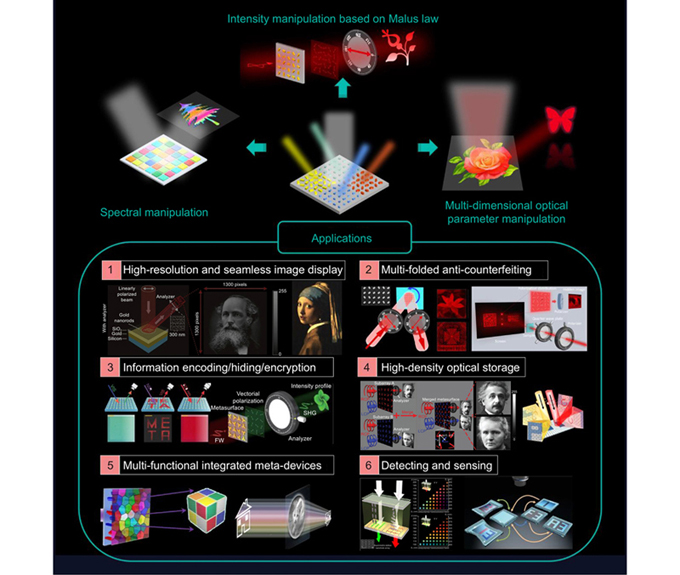暨南大学纳米光子学研究院广东省纳米光学操控重点实验室,广东 广州 511443
信息技术的发展使得信息加密变得日益重要。光学加密作为一种信息加密手段,具有多维度和高并发速度等优势。然而,传统的光学加密方案往往需要复杂和笨重的光学元件,这导致器件难以小型化和便携化,同时也降低了加密效率。超构表面是一种人工设计的二维平面结构,能够在亚波长尺度上实现对光场的灵活调控,为光学加密提供了一个灵活的平台。近年来,基于超构表面的光学加密方法不断涌现,其利用光在输入端和输出端的多维度来增加加密的复杂度和安全性。基于此,根据加密的端口类型,分别从单一输入端、单一输出端以及输入-输出端联合三个方面对这些方法进行了分析和讨论,并对超构表面光学加密的未来发展趋势进行了展望。
光通信 超构表面 光学加密 多维光场 纳米打印 光学全息 输入-输出端口 中国激光
2023, 50(18): 1813004

Author Affiliations
Abstract
1 Electronic Information School, Wuhan University, Wuhan 430072, China
2 Chongqing Institute of Green and Intelligent Technology, Chinese Academy of Sciences, Chongqing 400714, China
3 Peng Cheng Laboratory, Shenzhen 518055, China
4 Wuhan Institute of Quantum Technology, Wuhan 430206, China
For a conventional cascaded metasurface, the combination channel and each single channel are mutually dependent because the phase modulation of a cascaded metasurface is the sum of each single one. Here we propose a cascaded metasurface that can independently encode information into multiple channels. Based on the orientation degeneracy of anisotropic metasurfaces, each single metasurface can produce a quick-response (QR) image in the near field, governed by the Malus law, while the combined channel can produce a holographic image in the far field, governed by geometric phase. The independent and physically separated trichannel design makes information encryption safer.
cascaded metasurfaces optical encryption holography nanoprinting Chinese Optics Letters
2023, 21(2): 020003

Author Affiliations
Abstract
1 School of Electronic Information and School of Microelectronics, Wuhan University, Wuhan 430072, China
2 Peng Cheng Laboratory, Shenzhen 518055, China
3 Wuhan Institute of Quantum Technology, Wuhan 430206, China
4 Hubei Luojia Laboratory, Wuhan 430079, China
![]()
![]() Metasurface-based nanoprinting (meta-nanoprinting) has fully demonstrated its advantages in ultrahigh-density grayscale/color image recording and display. A typical meta-nanoprinting device usually has image resolutions reaching 80 k dots per inch (dpi), far exceeding conventional technology such as gravure printing (typ. 5 k dpi). Besides, by fully exploiting the design degrees of freedom of nanostructured metasurfaces, meta-nanoprinting has been developed from previous single-channel to multiple-channels, to current multifunctional integration or even dynamic display. In this review, we overview the development of meta-nanoprinting, including the physics of nanoprinting to manipulate optical amplitude and spectrum, single-functional meta-nanoprinting, multichannel meta-nanoprinting, dynamic meta-nanoprinting and multifunctional metasurface integrating nanoprinting with holography or metalens, etc. Applications of meta-nanoprinting such as image display, vortex beam generation, information decoding and hiding, information encryption, high-density optical storage and optical anti-counterfeiting have also been discussed. Finally, we conclude the opportunities and challenges/perspectives in this rapidly developing research field of meta-nanoprinting.
Metasurface-based nanoprinting (meta-nanoprinting) has fully demonstrated its advantages in ultrahigh-density grayscale/color image recording and display. A typical meta-nanoprinting device usually has image resolutions reaching 80 k dots per inch (dpi), far exceeding conventional technology such as gravure printing (typ. 5 k dpi). Besides, by fully exploiting the design degrees of freedom of nanostructured metasurfaces, meta-nanoprinting has been developed from previous single-channel to multiple-channels, to current multifunctional integration or even dynamic display. In this review, we overview the development of meta-nanoprinting, including the physics of nanoprinting to manipulate optical amplitude and spectrum, single-functional meta-nanoprinting, multichannel meta-nanoprinting, dynamic meta-nanoprinting and multifunctional metasurface integrating nanoprinting with holography or metalens, etc. Applications of meta-nanoprinting such as image display, vortex beam generation, information decoding and hiding, information encryption, high-density optical storage and optical anti-counterfeiting have also been discussed. Finally, we conclude the opportunities and challenges/perspectives in this rapidly developing research field of meta-nanoprinting.
metasurface nanoprinting structural-color hologram multifunctional device Opto-Electronic Science
2022, 1(10): 220011
红外与激光工程
2020, 49(9): 20201036
1 吉林大学物理学院, 吉林 长春 130012
2 吉林大学电子技术与科学学院, 集成光电子学国家重点实验室, 吉林 长春 130012
现今各个应用领域的器件微型化、功能化和集成化的发展趋势,对微纳加工技术提出了巨大挑战。越来越多器件的核心设计都依赖于高度图案化的三维复杂微纳结构。3D飞秒激光纳米打印(FsLNP)是一种无掩模的、利用飞秒激光直写进行加工的三维增材加工技术。其高度可设计性和远超光学衍射极限的高加工精度能够充分满足复杂技术需求。基于3D飞秒激光纳米打印独特的双光子聚合机制,只要合理设计所需材料的光聚合方案和微纳结构,可以制备一系列效率高且性能优越的微纳器件。简要介绍了3D飞秒激光纳米打印的技术要点、基本原理和目前所涉及的典型应用。
激光技术 飞秒激光 3D纳米打印 双光子聚合 三维微纳结构 激光与光电子学进展
2018, 55(1): 011410